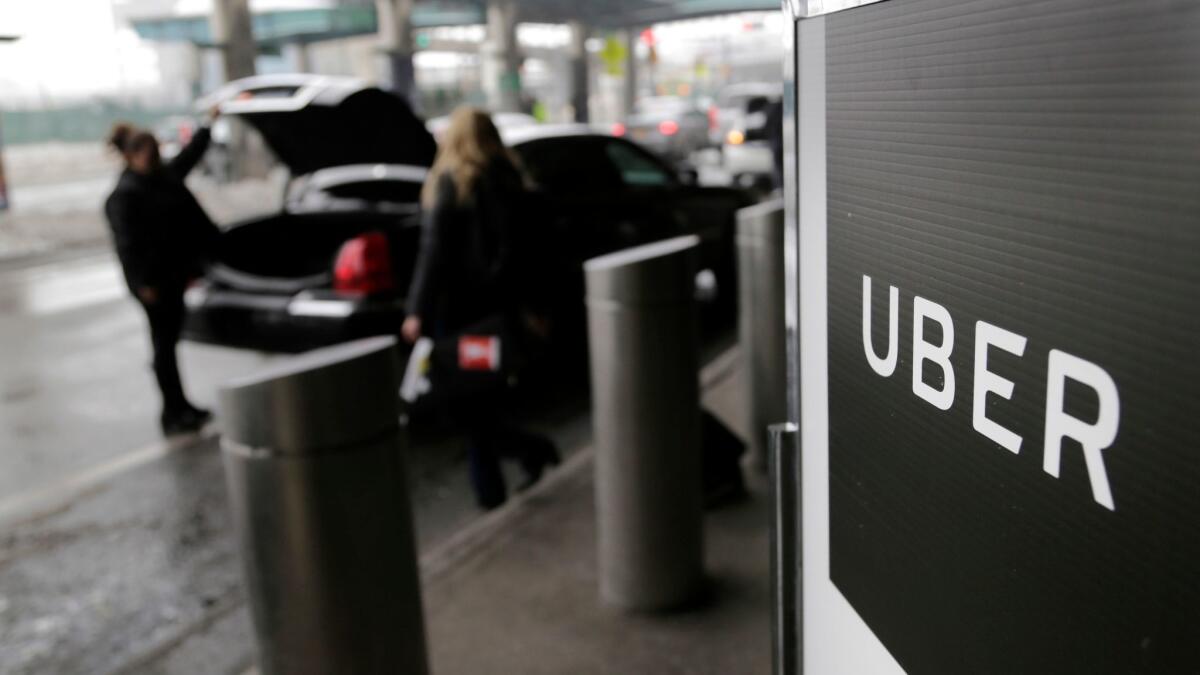Uber’s scandals test the patience of investors — and the public

- Share via
When you’re the hottest start-up in the world, investors will give you a pass for burning through as much as $1 billion a quarter. You’re growing your business, after all.
But when your company is consumed with complaints of pervasive harassment, mismanagement, executive firings and departures, a federal investigation for obstruction of justice and a lawsuit from a powerful rival alleging the theft of technology, such spending may face a bit more scrutiny.
For the record:
7:24 a.m. Jan. 19, 2025A previous version of this article referred to results set to be released Tuesday from an internal investigation at Uber. The investigation was run externally.
As Uber attempts to emerge from this litany of scandals — with the findings of an external investigation into its corporate culture set to be released Tuesday — the ride-hailing company faces new concerns. Will its misconduct harm its reputation with passengers? Could its tarnished stature hinder hiring? And will investors retain their confidence, and their willingness to underwrite Uber’s losses, under the current leadership?
If not, changes could be coming — and fast.
“An event like this is also an opportunity to do a reset that might never have happened,” said John Boudreau, a professor of business management at USC. “It’s very easy to plug along when investors and customers are providing money.”
The San Francisco company probably wouldn’t overhaul the business model that engineered its rise. But new leaders soon could have an opening to reshape specific practices as the company seeks to fill numerous executive positions and Uber’s visionary founder and chief executive, Travis Kalanick, reportedly considers an indefinite leave of absence following the sudden death of his mother last month.
Uber investors who have small stakes said Monday that though they remained excited about the company’s potential, they were looking forward to hearing what shake-up, if any, the board of directors might announce Tuesday. The directors, who include four investors and three employees excluding Kalanick, will have considerable sway over what strategies the company pursues.
Based on the estimates of private stock broker EquityZen, Kalanick could own as much as about 10% of Uber shares, although he and two supportive confidants reportedly hold voting control through supervoting shares.
Kalanick has faced scrutiny for fostering an environment where rule-breaking was condoned and not doing more to investigate reports of sexual harassment in the office. He’s combative in public and in private — a trait that has won him enemies and fans.
“They’ve got a lot of money and lot of good fundamentals,” Boudreau said. “If they can regain their image and the confidence of riders and investors, the potential is there to right itself. But this is definitely a new level of challenge for them.”
Kalanick has traded Uber shares for billions of dollars in cash during the last seven years, bringing the company to a market value of near $70 billion. Using the money to provide discounts to riders and bonuses to drivers has helped the company gain dominance over taxis and other competition.
The incentives have cut into the fees Uber collects as the matchmaker between drivers and customers. And expensive research into developing self-driving cars has eaten away at income too.
The company generated $6.5 billion in sales last year from the fees and posted a $2.8-billion loss. It pared its quarterly loss to $708 million to start 2017 from $991 million during last year’s fourth quarter. But the company remains far from producing the predictable financial results investors covet.
Though Uber has $7 billion in the bank, it will need to fundraise again by the end of next year at its current pace. Due to the recent scandals, raising funds will be difficult for the foreseeable future, start-up finance experts say.
If it can’t find investors, Uber could tap further into loans and credit lines. But shedding costs could be more prudent. Financial analysts have long expected Uber to slowly raise prices for customers to demonstrate a clearer road to profits by next year, when it might hold an initial public offering of its stock.
Accelerating the timeline and going leaner could be necessary not only to install more stringent human resources practices, but also to win back skeptical investors and drivers.
“One possible strategy to improve its image would be to pay drivers more and scale back its losses,” said Kevin Werbach, associate professor of legal studies and business ethics at the Wharton School at the University of Pennsylvania. “That would mean higher prices for riders.”
That move may not prove popular with passengers if rivals, such as Lyft, keep subsidizing passenger fares.
Uber declined to comment for this story. But the company has said its corporate issues haven’t had a significant effect on ridership, though 200,000 users deleted the app during a social media protest in Feburary. Indeed, Uber’s scandals haven’t led to sustained upticks in app downloads of rivals such as Ola in India or Lyft in the U.S., according to analysis by research firm Sensor Tower.
But there is evidence of brand damage within the technology community.
Discussions in women tech groups pointed to sexism and harassment at the company for years, says Allyson Kapin, founder of Women Who Tech.
“To rebuild that culture is going to take a long time — it’s going to take a complete leadership overhaul,” Kapin said.
Ksenia Coulter of Washington, D.C., said she deleted the Uber app from her smartphone after reading a blog post by former Uber employee Susan Fowler, whose writing about the lack of internal follow-up to sexual harassment complaints triggered investigations by the company and an independent counsel, former U.S. Atty. Gen. Eric H. Holder Jr.
“I never had a problem with drivers or the service and the app itself is pretty good, but it all piles up,” said Coulter, 27, who develops websites.
For drivers, revelations about Uber’s culture haven’t been a surprise, said Harry Campbell, a driver for both Uber and Lyft who blogs about the industry.
“A lot of Uber’s policies don’t value drivers who have been with the platform for years,” he said.
Drivers have voiced frustrations — most vocally about their classification as independent contractors rather than employees — though they have had less luck in finding a way to delete the app. Uber’s dominance makes it difficult to leave for a rival service full-time.
“I wish I could eliminate Uber from my life,” said Naftali Kamych, 43, who has been driving for Uber since 2011. He’s feuding with Uber management to get approval to use his 2017 Lincoln Continental, a $55,000 car he recently purchased, in Uber’s more lucrative Black service.
“You cannot survive without Uber today,” he said.
Public perception will matter when Uber tries to list shares on the stock market.
“If it did an IPO today, the valuation would probably be a lot lower than a year ago, even though the [financial results] haven’t changed dramatically,” Werbach said. “Ultimately, Uber’s biggest challenge is improving its culture and leadership. If it fails at that, its financing strategy won’t matter.”
Twitter: @peard33
ALSO
State regulators accept a proposal for studying clean alternatives to an Oxnard natural gas plant
A blond Julius Caesar in a business suit looks too familiar for comfort
Mnuchin calls for major rollbacks of Dodd-Frank financial reforms









